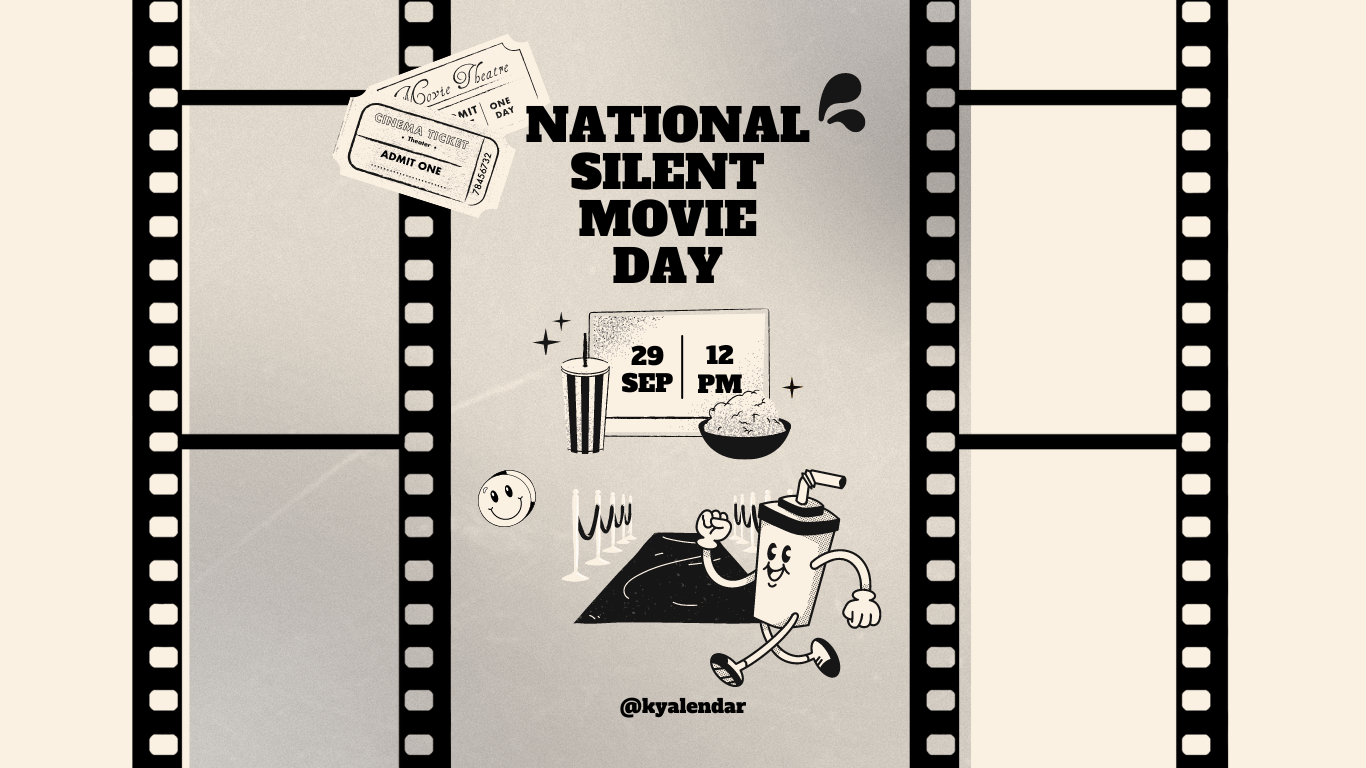
- This event has passed.
National Silent Movie Day
September 29

National Silent Movie Day is celebrated on the 29th of September each year, offering a unique opportunity to revisit and appreciate the early days of cinema. This day is dedicated to honouring silent films, which represent the foundation of the film industry as we know it today. Before the advent of synchronised sound in cinema, silent movies were the primary form of visual storytelling, relying heavily on expressive acting, innovative cinematography, and live musical accompaniment to convey narratives.
The Golden Age of Silent Films
The silent film era spanned from the late 19th century until the late 1920s. This period is often referred to as the “Golden Age of Silent Cinema,” a time when filmmakers were experimenting with the possibilities of this new medium. Without spoken dialogue, silent films relied on actors’ physical expressions, gestures, and title cards to convey the plot and emotions. This led to the development of a unique visual language that remains influential in filmmaking today.
Directors like Charlie Chaplin, Buster Keaton, and D.W. Griffith became pioneers of silent cinema, creating iconic films that are still celebrated for their artistic achievements. Chaplin’s “The Kid” (1921) and Keaton’s “The General” (1926) are examples of silent films that have stood the test of time, known for their innovative techniques and storytelling.
The Art of Silent Film
Silent films were more than just moving pictures without sound; they were a distinct art form. The absence of spoken words required filmmakers to be exceptionally creative in their use of visuals. Cinematographers experimented with camera angles, lighting, and editing techniques to create mood and atmosphere. Actors had to develop a heightened sense of physicality to express emotions clearly to the audience.
One of the key elements of silent cinema was the use of intertitles, which were text screens inserted between scenes to provide dialogue or narrative information. These intertitles were often artistically designed, contributing to the overall aesthetic of the film.
Another significant aspect of silent films was the role of music. Since the films themselves were silent, they were often accompanied by live music performed by a pianist, organist, or even a full orchestra in larger theatres. The music was not just background noise; it played a crucial role in setting the tone, highlighting dramatic moments, and enhancing the emotional impact of the story.
The Transition to Sound
The introduction of sound in cinema, marked by the release of “The Jazz Singer” in 1927, brought about a seismic shift in the film industry. As “talkies” (films with synchronised sound) became popular, the era of silent films began to wane. However, the transition was not immediate, and many filmmakers continued to produce silent films for a few more years, refining their craft and pushing the boundaries of visual storytelling.
While sound added a new dimension to cinema, the silent film era remains a critical chapter in the history of filmmaking. It laid the groundwork for many of the techniques and conventions that are still used in cinema today.
Celebrating National Silent Movie Day
National Silent Movie Day is an opportunity to revisit these classic films and recognise their importance in the history of cinema. On this day, film enthusiasts, historians, and cinema lovers come together to watch and discuss silent films. Many cinemas, film societies, and cultural institutions organise special screenings of silent films, often accompanied by live music to recreate the authentic viewing experience of the time.
For those who may not be familiar with silent films, National Silent Movie Day offers a chance to discover a whole new world of cinema. It’s an invitation to explore the roots of film and appreciate the artistry and innovation that characterised the silent era.
The Importance of Preservation
One of the key messages of National Silent Movie Day is the importance of preserving silent films. Unfortunately, many silent films have been lost over the years due to the fragile nature of the film stock used at the time and the lack of proper archival methods. It is estimated that around 75% of silent films are lost forever.
Film preservation organisations and archives work tirelessly to restore and preserve the remaining silent films, ensuring that future generations can experience these cinematic treasures. National Silent Movie Day serves as a reminder of the need to support these efforts and to recognise the cultural significance of silent films.
Conclusion
National Silent Movie Day is a celebration of the origins of cinema, paying tribute to the filmmakers, actors, and musicians who pioneered the art of visual storytelling. It’s a day to honour the creativity and innovation of the silent film era and to appreciate the lasting impact these films have had on the world of cinema. Whether you’re a seasoned film buff or new to silent films, National Silent Movie Day offers a unique opportunity to immerse yourself in the magic of early cinema and to recognise the importance of preserving these cultural gems for future generations.
Details
- Date:
- September 29